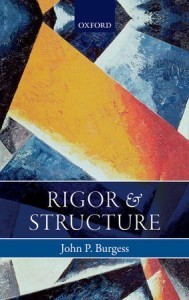Burgess, Rigor and Structure — 3
 As we saw, Burgess holds that the very project of rigorization calls for the development of a single unifying foundational system with “a common list of primitives and postulates”; but I suggested that the initial reasons he gives for this, at least, don’t seem particularly compelling. But there’s more. Burgess next notes that a number of constructions — e.g. taking ordered pairs, forming products, taking quotients, etc. — are used and re-used in various cases of manufacturing new spaces or number systems or whatever out of old ones. So there is here, he seems to think, another reason for providing a unified general framework in which all these constructions can be uniformly carried out. But at first blush it isn’t clear why this would take us in the direction of a single foundational system: you might instead think that what this suggests is that, inspired by seeing similarities in procedures in different areas, we should aim to develop a more general structural framework which makes it easier to spot more such similarities and port techniques developed in one area to another area (category theory, anyone?).
As we saw, Burgess holds that the very project of rigorization calls for the development of a single unifying foundational system with “a common list of primitives and postulates”; but I suggested that the initial reasons he gives for this, at least, don’t seem particularly compelling. But there’s more. Burgess next notes that a number of constructions — e.g. taking ordered pairs, forming products, taking quotients, etc. — are used and re-used in various cases of manufacturing new spaces or number systems or whatever out of old ones. So there is here, he seems to think, another reason for providing a unified general framework in which all these constructions can be uniformly carried out. But at first blush it isn’t clear why this would take us in the direction of a single foundational system: you might instead think that what this suggests is that, inspired by seeing similarities in procedures in different areas, we should aim to develop a more general structural framework which makes it easier to spot more such similarities and port techniques developed in one area to another area (category theory, anyone?).
So if there is a drive to a unified foundational system in the vicinity, I don’t think it can be just in the observation that such (surely anodyne) constructions as forming ordered pairs or taking quotients can be found across different areas of maths — these constructions, at least, seem pretty unproblematic. If there is a drive to seek foundations hereabouts it comes, surely, from much more specific concerns about certain distinctively infinitary constructions (which may in fact have their natural home just in one area of mathematics, in particular in analysis) — e.g. the repeated taking of limits or constructions that involve infinite sequences of choices, which seem to involve compellingly natural extensions of classical ideas yet whose legitimacy is open to challenge. We might now reasonably worry about consistency. (Burgess’s initial reasons for supposing that rigorization might lead us to seek a unified foundational theory had to do with consistency too — but those worries could be met by relative consistency proofs, it would seem, without seeking foundations. Now, however, we are in novel territory where we are tangling with the infinite in new ways that are simultaneously enticing and worrying, and so we feel a more pressing need to discipline them by reflecting on the principles underlying the new constructions.)
Which takes us to Cantor’s own route in to his set theory, and which Burgess (eventually) gets round to discussing. And now Burgess’s story becomes pretty conventional. First, there’s a lightning tour through some Cantorian themes, eventually noting Cantor’s own worrying falling short from rigour — his unacknowledged invocation of choice principles, his recognition (as we would put it) that not all predicates can have sets as extensions while lacking any sharp way of demarcating the “inconsistent multiplicities” from the kosher ones. Then there’s something about Russell’s vs Zermelo’s way of dealing with the paradoxes that threaten Cantor’s set theory, with Zermelo’s approach becoming the canonical one, to the point where it can be said that “From the 1950s onward, classical mathematics had just one deductive system, namely, first-order Zermelo-Fraenkel set Theory with Choice” [that’s Wilfrid Hodges, quoted by Burgess]. This is all done, however, very rapidly — most readers of this blog won’t need the reminders, while students for whom this is actually news might well find it all too quick to be very useful.
So far, then, I don’t think Burgess’s Ch. 2 is particularly satisfactory: but there is still more to come. In the second half of the chapter, Burgess turns to discuss some opponents of the project of rigorization when conceived as the project of regimenting mathematics into classical ZFC set theory. So that’s our next topic.



